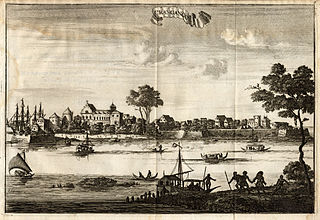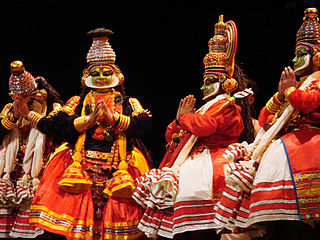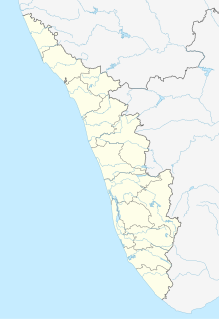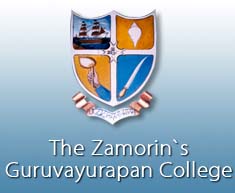
Guruvayur (ഗുരുവായൂര്) also written as Guruvayoor, is a municipal temple town in Thrissur District, of Kerala State in India.it is suburban town of thrissur city. It houses the Guruvayur Sri Krishna Temple, the fourth largest temple in India in terms of the number of devotees visiting per day.

Kodungallur, is a Municipality on the estuary of River Periyar in Thrissur district, Kerala on the Malabar Coast. It is situated 29 kilometres (18 mi) north of Kochi (Cochin) by National Highway 66. Kodungallur, being a port city at the northern end of the Kerala lagoons, was a strategic entry point for the naval fleets to the extensive Kerala backwaters.

C.H. Mohammed Koya was an Indian politician who served as the tenth Chief Minister of Kerala from 12 October to 1 December 1979. He was the leader of the Indian Union Muslim League.

Māmānkam was a duodecennial medieval fair held on the bank, and on the dry river-bed, of Pērār at Tirunāvāya, southern India. The Hindu temple associated with the festival was Nava Mukunda Temple, Tirunavaya. It seems to have begun as a temple festival, analogous to the Kumbha Melas at Ujjaini, Prayaga, Haridwar and Kumbakonam.

Sankaran Kutty Pottekkatt, popularly known as S. K. Pottekkatt, was an Indian writer of Malayalam literature and a politician from Kerala, India. He was the author of nearly sixty books which include ten novels, twenty-four collections of short stories, three anthologies of poems, eighteen travelogues, four plays, a collection of essays and a couple of books based on personal reminiscences. he was a recipient of Kerala Sahitya Akademi Award for Novel, Sahitya Akademi Award and the Jnanpith Award. His works have been translated into English, Italian, Russian, German and Czech, besides all major Indian languages.

Kochi is a small city located in the Ernakulam District in the Indian state of Kerala. Trivandrum which is the capital and largest city of Kerala is 200km away from Kochi.

Krishnaattam is a temple art in Kerala, India. It is a dance drama and presents the story of Krishna in a series of eight plays and was created by Manaveda, the then Zamorin Raja of Calicut in northern Kerala. The eight plays are: Avataram, Kaliyamardanam, Rasakrida, Kamsavadham, Swayamvaram, Banayuddham, Vividavadham and Swargarohanam. It survives in its glory at the Guruvayur Sri Krishna temple.

Samoothiri of Kozhikode is the hereditary title of the Hindu monarch of the kingdom of Kozhikode on Malabar Coast, India. The Samoothiris were based at the city of Kozhikode, one of the important trading ports on the south-western coast of India. At the peak of their reign, the Samoothiri's ruled over a region from Kollam (Quilon) to Panthalayini Kollam (Koyilandy).
Menoky is a Nair subcaste in the Indian state of Kerala. The Menoky are one of 14 "high caste" Nayar, and historically served as administrators of baronies and supervising accounts in temples.

Tirunavaya, also spelled as Thirunavaya, is a town in Malappuram, Kerala. Situated on the northern bank of Bharatappuzha, it is one of major Hindu pilgrimage centres in Kerala. Tirunavaya, home to Tirunavaya Temple and temples of Siva and Brahma, is one of the most prominent places for bali tarpana on Karkitaka vavu in Kerala.
Koya is a Muslim community, predominantly found in the city of Calicut in southern India. Scholars speculate Omani origin to the community and assume that the name is a corruption of the title “Khawaja”. The powerful Koyas held administrative positions in the medieval Calicut court (Zamorin).

Muchundi Mosque is a mosque located at Kuttichira, within in the city of Kozhikode (Calicut) in the Indian state of Kerala. Kuttichira is the medieval Muslim quarter in the city of Calicut. It is situated south of Mishkal Mosque, Kuttichira Tank and the Kuttichira Jum'ah Masjid. The mosque does not conduct the jum'ah prayers – the special noon service on Friday that all adult, male, free Muslims are obliged to attend.

Kingdom of Tanur was a coastal city-state in south-western India comprising parts of the present day Tirur and Ponnani tehsils in the state of Kerala. One of the numerous similar Hindu principalities along the Malabar Coast at the time, Tanur was ruled by a line of Nair rulers claiming Kshatriya status.

M.E.S. Ponnani College is an arts and science college run by MES situated at Ponnani,in the Malappuram district of Kerala, India. It is located on the coastal belt of Malappuram District between Tirur and Guruvayoor. It is affiliated to Calicut University.

His Highness Kizhakke Covilakam Manavedan Raja alias Cheriyanujan Raja (1855–1937) was an Indian aristocrat and administrator. He was the titular Zamorin of Calicut from 1932 to 1937.

Ravi Varma Raja (1745–1793) was a Samanta Kshatriya warrior prince of the Royal House of Zamorins from Calicut who fought a two-decade long revolt against the Mysore Sultanate under Hyder Ali and Tipu Sultan between 1766–1768 and 1774–1791, and later the British East India Company in 1793.

Kozhikode, also known as Calicut, is a city in the southern Indian state of Kerala. It is the third largest city in Kerala and the headquarters of Kozhikode district.
Valluvanad is a historical region between the knolls of Panthallur and the seashore villages of Ponnani.
Lakshminarayanapuram Ananthakrishna Krishna Iyer was an Indian Anthropologist and a writer of several books on the subject. He was the head of the department of Anthropology at the University of Madras and was credited with studies on the tribal and scheduled caste people of Kerala, a work initiated by his father, L. K. Ananthakrishna Iyer, himself a noted anthropologist. Anthropology in India, Social History of Kerala, a two-volume historical study and The Travancore Tribes and Castes, a three-volume account of the tribal people of southern Kerala are some of his notable works. The Government of India awarded him the third highest civilian honour of the Padma Bhushan, in 1972, for his contributions to science. His son, L. K. Balaratnam, is also a known anthropologist. His daughter, L.K. Ganga Bhagirathy married K.A.Seetharaman, Chief Engineer of the Tamil Nadu Electricity Board. Seetharaman was recently awarded IET CLN Life Time Achievement Award in IET CLN & YP Awards 2016 - 2017 for his outstanding contributions to The Institution of Engineering and Technology.




















